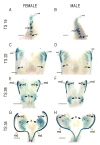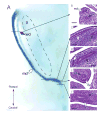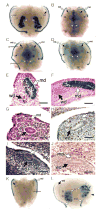Cellular mechanisms of Müllerian duct formation in the mouse
- PMID: 17467685
- PMCID: PMC2730733
- DOI: 10.1016/j.ydbio.2007.03.027
Cellular mechanisms of Müllerian duct formation in the mouse
Abstract
Regardless of their sex chromosome karyotype, amniotes develop two pairs of genital ducts, the Wolffian and Müllerian ducts. As the Müllerian duct forms, its growing tip is intimately associated with the Wolffian duct as it elongates to the urogenital sinus. Previous studies have shown that the presence of the Wolffian duct is required for the development and maintenance of the Müllerian duct. The Müllerian duct is known to form by invagination of the coelomic epithelium, but the mechanism for its elongation to the urogenital sinus remains to be defined. Using genetic fate mapping, we demonstrate that the Wolffian duct does not contribute cells to the Müllerian duct. Experimental embryological manipulations and molecular studies show that precursor cells at the caudal tip of the Müllerian duct proliferate to deposit a cord of cells along the length of the urogenital ridge. Furthermore, immunohistochemical analysis reveals that the cells of the developing Müllerian duct are mesoepithelial when deposited, and subsequently differentiate into an epithelial tube and eventually the female reproductive tract. Our studies define cellular and molecular mechanisms for Müllerian duct formation.
Figures







References
-
- Carroll TJ, Park JS, Hayashi S, Majumdar A, McMahon AP. Wnt9b plays a central role in the regulation of mesenchymal to epithelial transitions underlying organogenesis of the mammalian urogenital system. Dev Cell. 2005;9:283–92. - PubMed
-
- Colas JF, S GC. Towards a cellular and molecular understanding of neurulation. Dev Dyn. 2001;221:117–145. - PubMed
-
- Dohr G, Tarmann T, Schiechl H. Different antigen expression on Wolffian and Mullerian cells in rat embryos as detected by monoclonal antibodies. Anat Embryol (Berl) 1987;176:239–42. - PubMed
-
- Drews U. Direct and mediated effects of testosterone: analysis of sex reversed mosaic mice heterozygous for testicular feminization. Cytogenet Cell Genet. 1998;80:68–74. - PubMed
-
- Dyche WJ. A comparative study of the differentiation and involution of the Mullerian duct and Wolffian duct in the male and female fetal mouse. J Morphol. 1979;162:175–209. - PubMed
Publication types
MeSH terms
Grants and funding
LinkOut - more resources
Full Text Sources
Other Literature Sources
Molecular Biology Databases
Research Materials

